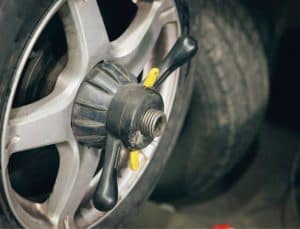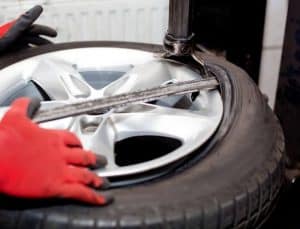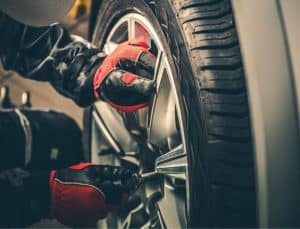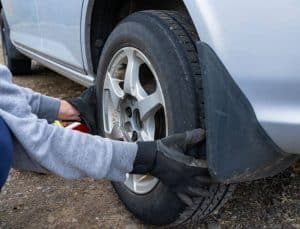I know you are struggling to find answers to the above question; it’s obvious to be concerned. Did you know that tires are the only vehicle components that connect directly to the road? And did you know that swapping the front tires with rear ones can enhance the vehicle’s overall performance?
I thought you should. After realizing this, now the question is when is the right time for tire rotation. One of the common determinants is always the user manual; your vehicle’s manufacturer includes a timescale for rotating the tires. If you know nothing about this act, you don’t have to worry; this article contains everything to sharpen you.
Rota Tires at 10’000 Miles: The Right Time for Tire Rotation
Vehicles can be rear-drive, front-drive, or four-wheel drive based on the brand. Tires wear out differently, but experts affirm that driven wheels are associated with faster wear due to more work they do.
For example, a front-wheel-drive vehicle primarily uses its front wheels when steering, putting down the pavement, and braking power. It performs all these functions while supporting the mounted transaxle and engine at the bonnet. These components are heavy, quickening the wear rate of front tires.
Now by swapping your vehicle’s tires, you encourage them to wear out evenly. Doing so will also extend their lifespan, sparing you from premature replacements. For this reason, some experts recommend tire swaps should be done about every 5000 or 10000 miles.
Sometimes you might be forced to swap the tires if a pair’s condition is too bad. Besides, you can do this when going for the oil change. This implies that you can swap the tires sooner or longer based on their conditions.
Once you’ve realized that they are still in good condition, check on the user manual and confirm when you should rotate them. If the user manual does state for a regular oil change, you should schedule tire swaps for at least half a year.
Swapping the tires encourages even wear, making them long-lasting. Proper rotation comes with many benefits, like equalizing the working condition of all four tires. Check the condition of your vehicle’s tires after every winter before transiting to spring.
Inspect the tires’ inside and outside shoulder for any damage, mainly from potholes. Besides, you need to extend the inspection and look at the condition of the wheel rims. Wheel rims can be affected by hard impacts on potholes; straighten the bent. Don’t forget to check on the rim’s inboard side form; many people tend to neglect such a hidden part.
What is tire cupping?
Tire cupping remains an essential mechanism in vehicles for their suspension. However, some professionals assert that this problem is mainly associated with older vehicles. But that doesn’t mean that your newly bought vehicle can’t suffer from cupping.
As a result of uneven tire tread patterns, if neglected, the vehicle’s steering, braking ability, and the ride can be affected. The tire will wear out prematurely, forcing you to go for replacements sooner than expected—some of the common signs that your tire swaps are; blisters and cupping.
Deep pothole slams mainly cause blisters. When the tire is pinched, there might be a tear inside. Once the air gets into the tire, the blister is the next thing that you will get. Ignoring such a problem will eventually lead to blowouts and flat tires that can lead to a critical accident.
Tire rotation patterns
Based on the Tire Rotation Industry Association, there are only three types of tire rotation patterns that most vehicles use. This only happens if they drive on equal-size tires. The rear and front tires should be uniform when it comes to wearing, and they shouldn’t be unidirectional.
It’s therefore advisable that your tires rotate in one direction only to operate appropriately. Tire rotation is affected by factors like whether the vehicle’s tire is non-directional or direction, same or vary in size, or whether there’s a full-size rotation spare or it’s temporal.
Below are some of the common rotation patterns stipulated by the Tire and Rim Association standardizing body.
For non-directional and uniform size tires
Rearward cross
For all-wheel cars, rear-wheel, or 4-wheel drive, experts recommend reward cross pattern. This is the act of moving the rear tires to the front axle without interchanging their sides.
On the other hand, the rear tires’ positions are interchangeably moved to opposite sides’ rear axles. This means the left tire from the front axle will go to the right rear axle and vice versa.
X-pattern
If your vehicle is a front-wheel drive, then this is the best rotation pattern for you. It’s suitable for sedans and lightweight trucks. Here, all the tires are rotated diagonally. The “X” symbol should help you do this. The left rear tire should be swapped with the right tire on the front axle, while the right tire on the rear axle should be swapped with the left tire on the front axle.
It’s simple once you understand the symbol “X.”
Forward cross
For those with front-wheel drive cars, here is your best tire rotation pattern. The act involves moving the front tires to the back directly. On the other hand, you will have to move the rear tires to the front axle opposite sides, diagonally.
Non-directional and uniform-sized tires using a full-size spare tire
To ensure that your tires wear uniformly, there’s needed to rotate your vehicle’s full-size spare tire together with the other 4. This act is essential, especially for 4-wheel or all-wheel drive cars where a slight difference may result in undue strain on your vehicle’s drive train.
Rearward cross for 4-wheel or rear-wheel drive vehicles
Under this category, all the axles are moved directly on the front axle. On the other hand, the spare tire will move to the rear axle right side. More so, the right front tire should move back diagonally to the rear axle left side. Now, the left front tire will be your new spare tire.
Forward cross for front-wheel-drive cars
Here, it would help if you moved the rear tires diagonally to the front axle on opposite sides. The front tire on the right axle will automatically become your new spare tire. Remember, you should position the spare tire on the rear axle right side while the front axle left tire should be moved back to the left rear directly.
For directional and high-performance tires
Side-to-side
This process is significant for defiantly-sized performing tires on the rear and front axles. This process is not a big deal since you only have to swap the size’s tires, maintaining their axle. The left rear tire on the left axle is swapped with the right one on the same axle.
Front-to-back
This tire rotation is mainly suitable for directional tires. It involves swapping the front tires with rear ones without changing their side. Let the left tires remain on that side; don’t swap them with those on the car’s right side.
In simple words, you need to swap the left tire on the front axle with that of the front axle on the same side.
You need to pay extra attention to rotating tires in a vehicle with different-sized tires. If you still hold some doubts, it’s advisable to revise the owner’s manual for correct and successful tire rotation. Besides, you can seek the help of an expert to help get away with rotation.
But, whatever you will do, try to rotate your tires after every 7500 or 10000 miles. This depends on the type and manufacturer of the tires with your vehicle. Other models can call for a rotation even after 5000 miles, based on the terrain you usually drive on.
Frequently asked questions:
- Is often the tire rotating wrong?
Tire rotation is significant in bettering the overall performance of the vehicle. It also evens their wear rate, sparing you from premature tire replacement. Often tire rotation can be advantageous, but at the same time disadvantageous.
Experts recommend tire rotation after every 5000 miles or 7500 miles. Sooner rotations may affect the vehicle’s wheels and rims.
- Is alignment a must after rotating my tires?
Absolutely no. It’s not necessary. Do so only if the vehicle’s condition is terrible or your road is full of potholes. You should align the vehicle when replacing the tires and not rotate. You also don’t have to balance the car during rotation.
- When should I rotate my tires?
Immediately when you start seeing blisters and uneven wear of the tires.
Conclusion
Tire rotation is inevitable, and experts recommend the act to after every 5000 to 10000 miles. Swapping your vehicle’s tires comes with many benefits like extending their lifespans, improving overall vehicle’s performance, saving you some money, etc.
Proper rotation will automatically spare you from premature tire replacements. So, tire rotation is one of the significant ways to buy sometimes before going for a replacement. Doing so also protects other parts of the vehicle like shocks, steering wheel, and rims.
